
by Deep Green Resistance News Service | Mar 17, 2019 | Colonialism & Conquest
Featured image: The collusion between officials and poachers was exposed in India’s Down to Earth magazine. © Down to Earth
by Survival International
Park officials in India’s Rajaji Tiger Reserve colluded with poachers in the killing of endangered leopards, tigers and pangolin, according to an investigation by a senior wildlife officer.
The accused officials range from the park director to junior guards. WWF-India boasts that it trained “all Rajaji frontline staff in skills that were vital for protection,” including law-enforcement. It also provided vehicles, uniforms and essential anti-poaching equipment to the guards.
The investigation, reported in India’s Down to Earth magazine, found that not only were officials helping to hunt down and kill wildlife, they also beat and tortured a man named Amit – an innocent villager who was trying to stop the poaching.
Officials are reported to have arrested Amit under false charges, resulting in him being detained for up to a month. He was also beaten and given electric shocks by a wildlife warden and two range officers.
These revelations of serious human rights abuses by guards trained and supported by WWF follow the recent Buzzfeed exposés that WWF funds guards who kill and torture people.
The involvement of those supposed to protect wildlife in hunting is common. A UN report in 2016 confirmed that corrupt officials are at the heart of wildlife crime in many parts of the world, rather than tribal peoples who hunt to feed their families.
Stephen Corry, Survival International’s Director, said today: “Rangers who poach as well as violate human rights won’t surprise those environmentalists who’ve been speaking against fortress conservation for years. Corrupt rangers often collude with poachers, while tribal people, the best conservationists, bear the brunt of conservation abuses.”
by Deep Green Resistance News Service | Sep 25, 2017 | Colonialism & Conquest
Featured image: World Wildlife Fund (WWF) has been working in the Congo Basin for decades – supporting squads who have committed violent abuse against tribal people. © WWF
by Survival International
A new Survival International report details widespread and systematic human rights abuses in the Congo Basin, by wildlife guards funded by the World Wildlife Fund (WWF) and other big conservation organizations.
The report documents serious instances of abuse between 1989 and the present day in Cameroon, the Republic of Congo, and the Central African Republic (CAR) by guards funded and equipped by WWF and the Wildlife Conservation Society (WCS), the parent organization of New York’s Bronx zoo.
It lists more than 200 instances of abuse since 1989, including pouring hot wax onto exposed skin, beating, and maiming with red-hot machetes. These incidents are likely just a tiny fraction of the full picture of systematic and ongoing violence, beatings, torture and even death.
As well as these especially cruel incidents, the report also documents the forms of harassment that have become part of everyday life for many people, including threats, and the destruction of food, tools and personal belongings.
Read the full report here.

WWF funded guards in Gabon. © WWF
As well as Survival, over the past three decades, numerous independent experts and NGOs have raised concerns about these abuses. These have included NGOs like Greenpeace, Oxfam, UNICEF, Global Witness, Forest Peoples Programme, and research specialists from University College London, the University of Oxford, Durham University, and Kent University.
WWF and WCS have even partnered with several logging companies, despite evidence that their activities are unsustainable, and have not had the consent of tribal peoples as required by international law and their own stated policies.
One Bayaka man said: “A wildlife guard asked me to kneel down. I said: “Never, I could never do that.” He said: “If you don’t get down on your knees I’m going to beat you.”
A Baka woman said: “They took me to the middle of the road and tied my hands with rubber cord. They forced my hands behind my back and cut me with their machete.”

Survival has documented hundreds of instances of abuse, and collected testimonies from many “Pygmy” people. © Survival International
A Bayaka woman said: “They started kicking me all over my body… I had my baby with me. The child had just been born three days before.”
Tribal peoples have been dependent on and managed their environments for millennia. Their lands are not wilderness. Evidence proves that tribal peoples are better at looking after their environment than anyone else.
But big conservation organizations like WWF are partnering with industry and tourism and destroying the environment’s best allies. Now tribal people are accused of “poaching” because they hunt to feed their families. And they face arrest and beatings, torture and death, while big game trophy hunters are encouraged.
Survival’s Director Stephen Corry said: “This shocking report lays out, in detail, the abuse and persecution that “conservation” has brought the indigenous and tribal peoples of the Congo Basin. These are just the cases that have been documented, it’s impossible to imagine there aren’t a lot more which remain hidden.
“The big conservation organizations should admit that their activities in the region have been catastrophic, both for the environment and for the tribal peoples who guarded these forests for so long.
“WWF and WCS supporters might ask these organizations how they could have let this situation carry on for so long – and what they’re going to do now to make sure it stops.”
“Pygmy” is an umbrella term commonly used to refer to the hunter-gatherer peoples of the Congo Basin and elsewhere in Central Africa. The word is considered pejorative and avoided by some tribespeople, but used by others as a convenient and easily recognized way of describing themselves.
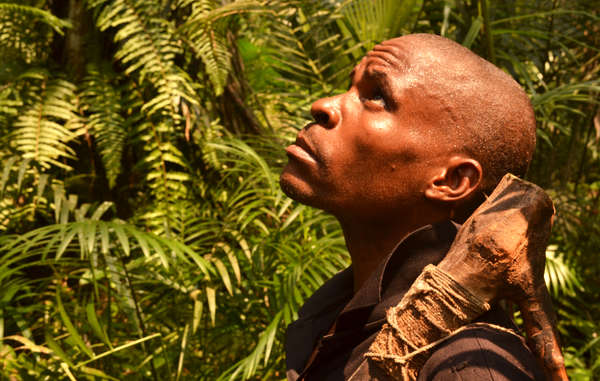
by Deep Green Resistance News Service | Jun 30, 2017 | Colonialism & Conquest
Featured image: Vast swathes of the Bayaka’s ancestral homelands in the Republic of Congo have been taken over without their consent by loggers and big conservation NGOs. © Lambert Coleman
by Survival International
An investigation by Survival International has revealed that the Wildlife Conservation Society (WCS), the parent organization of New York’s Bronx Zoo, is funding the abuse and eviction of Bayaka “Pygmies” and other rainforest tribes in the Republic of Congo.
WCS manages and helped create a national park on Bayaka land without the tribe’s consent, and has formed a partnership with two logging companies working on their land. WCS is also funding anti-poaching squads which prevent the Bayaka from entering their ancestral lands, and Survival International has documented dozens of instances of harassment, beatings and even torture.
The Bayaka are frequently accused of “poaching” when they they hunt to feed their families. Tribal people have complained that this diverts action away from tackling the true poachers – criminals conspiring with corrupt officials.
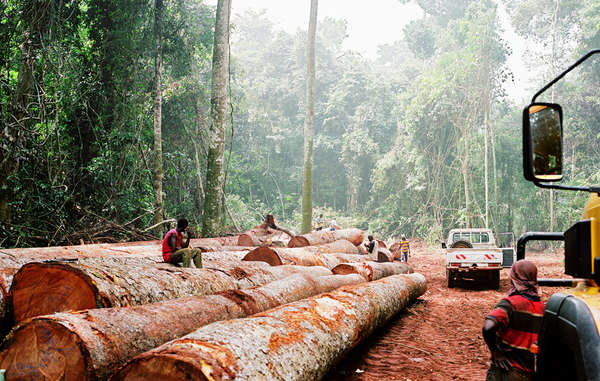
Big conservation has failed to prevent widespread logging on tribal land, and has actively contributed to serious human rights abuses. © Kate Eshelby /Survival
Victims have included children, the elderly and disabled people. In 2012, for example, a severely disabled tribal man was assaulted by guards. In May 2016, one man was hospitalized after he and four others were brutally beaten by guards. Forest camps are frequently destroyed, and tribal people are attacked and tortured for accessing land which they have been dependent on and managed for generations.
A Bayaka man said: “If you go into the park they will get you and take you to prison. Even outside the park they say ‘We’re going to kill you. Get out, get out, get out.’”
Logging in the region continues at unsustainable levels, according to reports by independent researchers and advocacy groups, including Greenpeace. Many observers including the United Nations and Congolese organization l’Observatoire congolais des droits de l’homme, have been warning about the consequences of ecoguard abuse since at least 2004, but no effective action has been taken.
In 2005, a Bayaka man reported that: “We met another white man [from WCS] who came to tell us to stop hunting and that the wildlife guards would make sure we did. Now we are afraid to go far in the forest in case the wildlife guards catch us.”
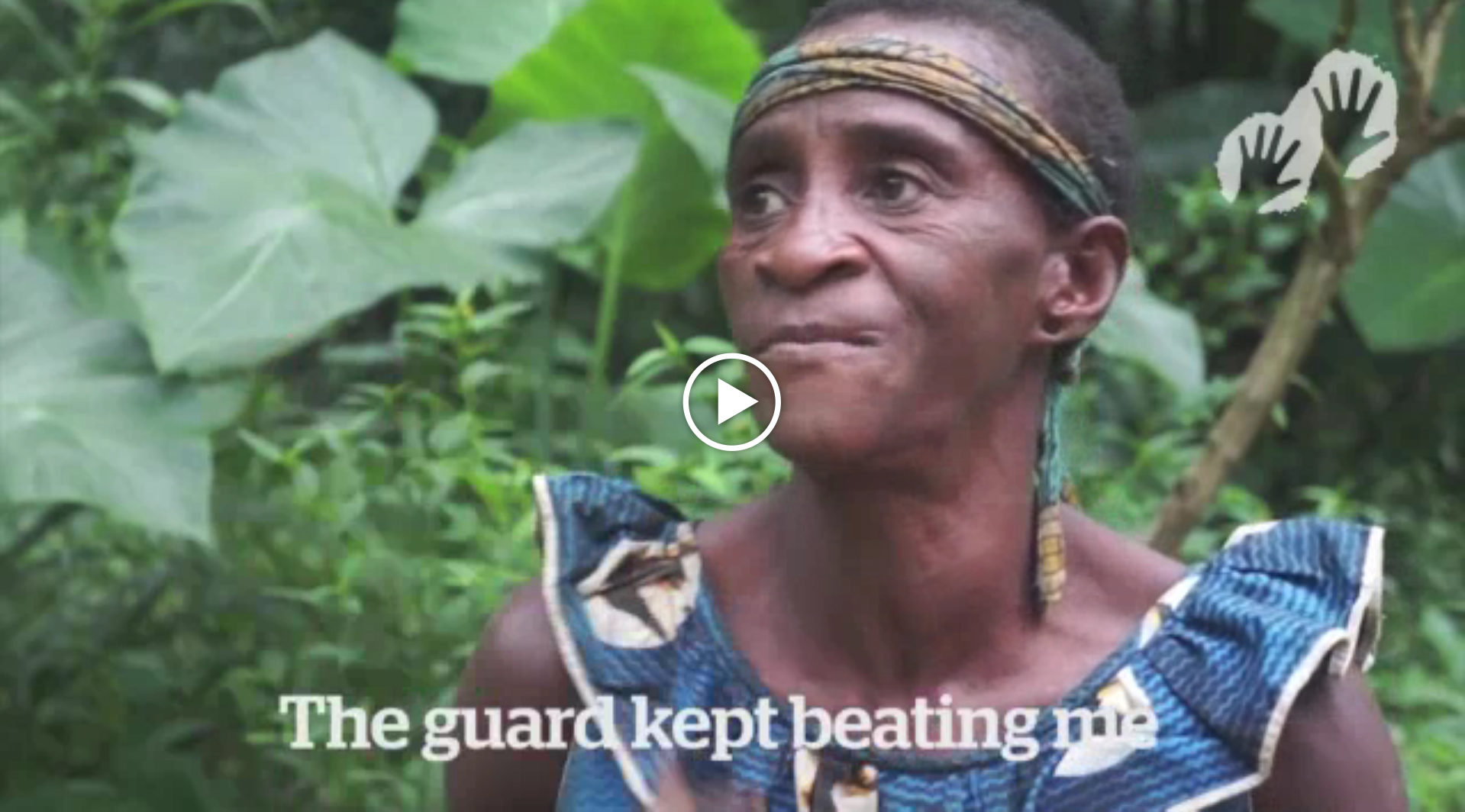
Watch: Apfela describes how wildlife guards, supported by the Wildlife Conservation Society, brutally attacked her.
Survival’s Director Stephen Corry said: “Conservation in the Congo Basin is based on land theft. National parks are created on indigenous peoples’ territories without their consent: It’s land-grabbing (with a “green” label) and the big conservation organizations, like WCS, are guilty of supporting it. Survival International is doing all it can to stop this “green colonialism.” It’s time for conservationists to respect land rights, stop stealing tribal peoples’ ancestral homelands, and obtain proper permission for every project they seek to carry out on tribal land.”
Background briefing
-WCS is one of the world’s oldest conservation organizations, founded in 1895.
-WCS backed the creation of Nouabalé-Ndoki National Park in 1993 without the Bayaka’s consent. It manages the park to this day.
– The organization runs an annual “Teddy Roosevelt Award” for conservation. In 2017, the award generated controversy when it was presented to Gabon’s president Ali Bongo, who has been widely criticized for his government’s record of human rights abuse. According to some reports, Bongo donated $3.5m in exchange for the award.

Madison Grant, notorious eugenicist and founder of the organization which would become the Wildlife Conservation Society (WCS). © Wikimedia Commons
– The Bronx Zoo and the conservation organization that would become WCS were founded by eugenicist author Madison Grant. Infamously, they brought a “Pygmy” man, Ota Benga, to the zoo in the early 1900s. He was exhibited to the public, and encouraged to live in the zoo’s monkey house. He committed suicide in 1916.
– Bayaka people in the Central African Republic and Republic of Congo wrote open letters to WCS and its funders in 2016.
– The abuse of Bayaka by WCS-supported squads has been documented for at least 18 years, but the organization has failed to take effective action to stop it.
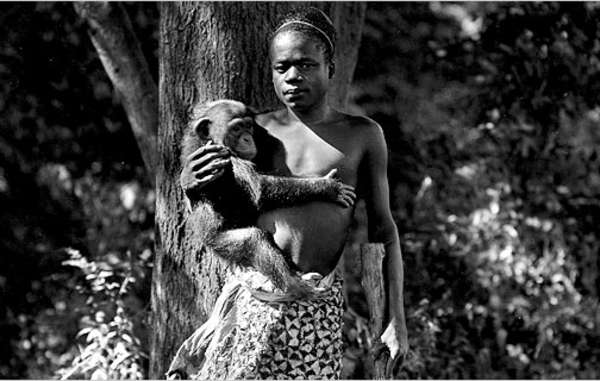
Ota Benga, a Congolese ‘Pygmy’ man who was transported to the US and exhibited in zoos, before committing suicide in 1916. © Wikimedia
WCS is not the only multinational NGO implicated in the abuse of tribal peoples. Many of the big conservation organizations are partnering with industry and tourism and destroying the environment’s best allies.
It’s a con. And it’s harming conservation. Survival International is leading the fight against these abuses, for tribes, for nature, for all humanity.
“Pygmy” is an umbrella term commonly used to refer to the hunter-gatherer peoples of the Congo Basin and elsewhere in Central Africa. The word is considered pejorative and avoided by some tribespeople, but used by others as a convenient and easily recognized way of describing themselves.
Some names have been changed to protect tribal people’s identity.
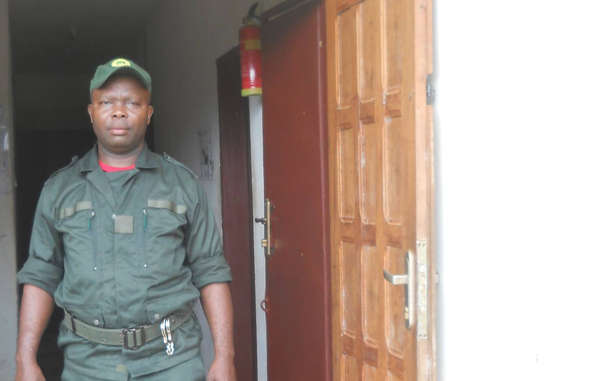
by Deep Green Resistance News Service | Jun 14, 2016 | Biodiversity & Habitat Destruction
Featured image: Cameroonian “ecoguard” Mpaé Désiré, who in 2015 was accused of beating Baka and in 2016 was arrested for involvement in the illegal wildlife trade. © Facebook
A new UN report has confirmed that corrupt officials are at the heart of wildlife crime in many parts of the world, rather than terrorist groups or tribal peoples who hunt to feed their families.
The reports’ findings have coincided with a wave of arrests of wildlife officials across Africa and Asia, raising concerns of a global “epidemic” of poaching and corruption among armed wildlife guards who are supposed to be protecting endangered species.
Recent conservation corruption arrests include:
-A wildlife guard in Cameroon, Mpaé Désiré, and a local police chief who were arrested on suspicion of involvement in the illegal ivory trade on the ancestral land of the Baka “Pygmies” and other rainforest tribes. Mr Mpaé has been accused by Baka of beating up tribespeople and torching one of their forest camps after accusing them of poaching.
The World Wildlife Fund (WWF) has been funding wildlife guards in this part of Cameroon since at least 2000, despite reports of guards arresting, beating and torturing tribal hunters.
One Baka man told Survival in 2013: “Ecoguards used to open tins of sardines and leave them as bait to attract leopards, so they could hunt them for their skins.”
Another said: “The ecoguards don’t want anyone in the forest at all so that no one hears the gunshots as they poach.”
Elsewhere:
– Four park employees in India have been arrested for involvement in poaching endangered one-horned rhinos in the notorious Kaziranga reserve, where wildlife guards are encouraged to shoot on sight anyone they suspect of poaching. 62 people have been killed there in just nine years.
– A forest officer has been arrested near Kaziranga after police found a tiger skin and ivory in his house.
– In the Pench tiger reserve in central India, a guard, named in reports as Vipin Varmiya, has been arrested for killing a tiger and her two cubs.
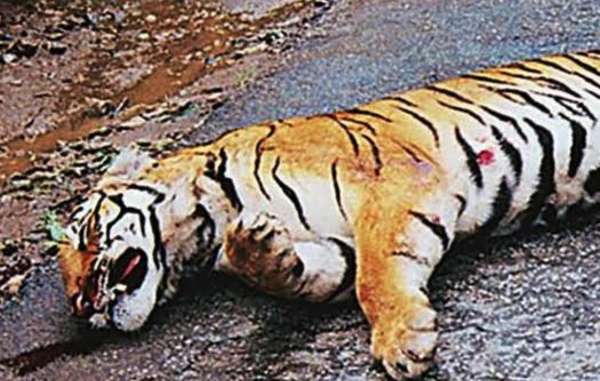
A tiger was allegedly killed by a park guard in Pench tiger reserve, India © Survival International
A recent Brookings Institution Report confirmed that the big conservation organizations are failing to tackle the true poachers – criminals conspiring with corrupt officials. The link between corruption and wildlife crime has also been reported in Tanzania, South Africa, Kenya, Zimbabwe, Uganda and Indonesia.
The involvement of armed guards in poaching, in countries where militarized conservation tactics are employed, raises questions over the advisability of using violence and intimidation to protect flora and fauna. In many parts of the world, armed conservation has led to violence against local tribal peoples, including in Cameroon, and in India where summary execution in the name of conservation is in danger of becoming more widespread.
In February 2016, Survival filed an OECD complaint against the World Wildlife Fund (WWF) for its involvement in funding repressive and often violent conservation projects in southeast Cameroon, rather than tackling the real poachers. Persecuting the environment’s best allies in place of real action to tackle these systemic problems is harming conservation.
Survival’s Director Stephen Corry said: “Conservation’s response to poaching has been to accuse local tribespeople when they hunt to feed their families, to support the use of shoot-to-kill policies and to blame terrorists. None of it works; it’s harming conservation. The true poachers are the criminals, including ecoguards, who conspire with corrupt officials. As the big conservation organizations partner with industry and tourism, they’re harming the environment’s best allies, the tribal peoples who have been dependent on and managed their environments for millennia. Tribespeople should be at the forefront of the environmental movement, they know who the poachers actually are, they can protect their land from logging, they protect biodiversity, and are better at looking after their environment than anyone else.”
Notes: Latest reports indicate Mr Mpaé has been released from custody and is awaiting trial.
“Pygmy” is an umbrella term commonly used to refer to the hunter-gatherer peoples of the Congo Basin and elsewhere in Central Africa. The word is considered pejorative and avoided by some tribespeople, but used by others as a convenient and easily recognized way of describing themselves.
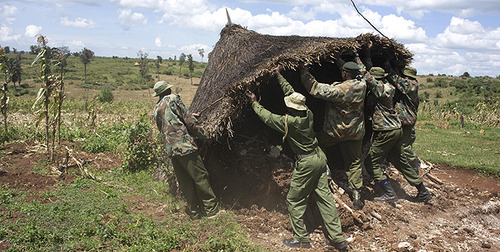
by Deep Green Resistance News Service | Feb 7, 2015 | Colonialism & Conquest, Indigenous Autonomy
By Stephen Corry / Survival International
Twenty years ago, fundraising publicity for the World Wildlife Fund (WWF) posed a very odd question: whether to send in the army or an anthropologist to stop indigenous people destroying the Amazon rainforest. Equally bizarre, it claimed that the media was “inundated with appeals to save native peoples” and asked, “Do they really deserve our support?” The world’s leading conservation organization went on by saying that tribes had learned many things from outsiders, including “greed and corruption.” WWF’s answer to this apparent dilemma was thankfully not the army, but for concerned people to give it more money (its daily income is now $2 million) so it could “work with native peoples to develop conservation techniques.”
At Survival International, we were dismayed, and so were tribal organizations when we showed them the advertisement. For WWF to blame “duped” tribespeople for deforestation was serious enough (giving the impression they trumped conservationists in attracting more funding was laughable), but even mentioning soldiers in the same sentence as conservationists uncomfortably echoed the latter’s dubious roots in colonialist ideology.
However, WWF’s assertions are likely to have raised more eyebrows with its supporters than with many tribal people, for whom big conservation organizations have long been considered in the same bracket as development banks, road and dam builders, miners and loggers. All, they would say, are outsiders bent on stealing tribal lands.
Over the last 20 years, some conservation groups have at least cleaned up their language: Their policies now make claims about working in partnership with local tribal communities, about consulting them and about how much they apparently support UN standards on indigenous rights. There are undoubtedly many in the conservation industry who believe all this, and who realize that tribal peoples are – as a broad principle – just as good conservationists as anyone else, if not considerably better.
Even those who disagree do at least recognize that alienating local people – whether tribal or not – eventually leads to protected areas being opposed and attacked. It’s one reason why the conservation industry makes much, at least on paper, of bringing local communities on board. But apart from written policies, how much have things really changed in the last 20 years? Tragically for many, the answer is “not much”; in some places, they’re getting worse.
“Voluntary Relocation” From Tiger Reserves
For example, the WWF-inspired tiger reserves in India are increasingly used to expel tribes from their forests so they can be opened up to tourism. The people are bribed with a fistful of rupees to give up the land, which has sustained their families for countless generations. More often than not, promises are broken and they’re left with empty pockets and a few plastic sheets for shelter. Whether any financial incentives materialize or not, they are backed up with threats and intimidation: Tribes are repeatedly told that if they don’t get out, their homes and crops will be destroyed and they’ll get nothing. When they finally cave in to this pressure, the conservationists call it “voluntary relocation.” Needless to say, it’s illegal.
It might surprise people to know there’s evidence that tigers thrive in the zones where tribal villages remain – the people’s small open fields encourage more tiger prey than in the enclosed forest. When they’re kicked out, their old clearings give way to roads, hotels and truckfuls of gawping tourists. Studies show animal stress behavior increases with tourism. In other words, if you want happy tigers, then it’s much better to leave the tribal people where they’ve always been. They are surely the best eyes and ears to report any poaching activity anyway; Baiga villagers from the famous Kanha reserve respect the big cats as their “little brothers.”
Hunters or Poachers?
Guards in tiger reserves intimidate and beat tribespeople found on land that was once their ancestral forests. But at least they stop short of the torture to which the Baka “Pygmy” people in Cameroon are subjected by anti-poaching forces. To return to the advertisement: Conservation is sending in soldiers, just as it always has. Heavily armed, government paramilitary squads accompany “ecoguards,” which are equipped using WWF funds. They beat those thought to have entered the protected areas, which are in fact Baka ancestral homelands. Tribespeople are assaulted even if they’re merely suspected of knowing those who have gone in. Meanwhile, their land is logged and mined, including by WWF partners. A Baka man told us, “They beat us at the WWF base. I nearly died.” WWF seems incapable of stopping these abuses. It has known about them for years, but is scathing about those who denounce them: Survival’s “absurd” campaign to draw attention to them would, it claimed, help the “real” criminals.
Tribal victims are invariably accused of “poaching,” a term which now means any sort of hunting, including for food, with which conservationists disagree. That certainly doesn’t encompass all hunting. Many conservation organizations, including WWF, don’t oppose fee-paying big game hunting. On the contrary, they profit from it, even quietly whispering that it’s a vital ingredient in conservation.
Senior environmentalists are not averse to having a shot themselves. The former president of WWF-Spain – the previous king of Spain – was recently photographed in Botswana with his elephant kill. The resulting scandal forced him to step down, but only because the picture was leaked. Kings can hunt elephants, which we’re told are threatened, but Bushmen can’t hunt to eat, not a single one of the plentiful antelope they’ve lived off sustainably since time immemorial. If they’re even suspected of it, they’ll be beaten and tortured like the Baka. This has been going on for decades, as the president of Botswana, Ian Khama, has tried to force all Bushmen out of their Central Kalahari region. In 2014, he banned hunting throughout the country – except for paid safari hunting of course. It was another illegal act in the guise of conservation.
Conservation and Diamond Mining
An avid environmentalist himself, and board member of Conservation International (CI) no less, General Khama claims he wants to clear the zone so that the wildlife will be undisturbed. This is decidedly odd because the fauna has been much disturbed over the last 20 years, but not by the remaining tribespeople: Mining exploration continues apace and you will soon be able to buy a diamond mined from inside the so-called game reserve. Due to go on sale around Valentine’s Day, these expensive love tokens now play a part in the destruction of the last hunting Bushmen in Africa.
In March, Khama is due to host the second United for Wildlife meeting – a consortium of the world’s major conservation organizations, including WWF and CI. A British royal will doubtless turn up and join the cry against “illegal poaching.” The assembly of conservationists, who routinely violate the law in their treatment of tribal peoples, will be hosted by a president guilty of trying to eradicate Bushmen hunters. No doubt the hypocrisy will be lost in the sanctimoniousness with which the press will accord the photo ops. The first United for Wildlife meeting, in London, was also hosted by Princes William and Harry – both had returned the previous day from hunting in Spain.
A couple of years ago, to the southwest of the Central Kalahari Game Reserve diamond mine, another Bushmen community was going to be thrown off their land because they had the temerity to remain where CI had tried to establish a new “wildlife corridor.” CI apparently has good policies, including having to consult the locals, so Survival International asked how it went about consulting with the Bushmen of Ranyane during its long, expensive Botswana study. Although the village is an easy four-hour drive from the nearest big town, CI admitted there had been no attempt to consult at all.
Conservation as a Feel-Good Commodity
If this handful of examples surprises anyone, it’s because the industry has poured enormous resources into gaining a place among the world’s most trusted brands. This long PR exercise has involved blurring and hiding (rather than honestly confronting) conservation’s colonial, indeed racist, past. Conservation has become a commodity, raising enormous sums of money, and rewarding supporters with an equally large feel-good factor, one that is nowhere near as straightforwardly apolitical as we are led to believe. Those who suggest “conservation” might not really be as holy as some claim are routinely denigrated as blasphemers and apostates.
If the movement is to have any chance of achieving its stated objectives – which I, for one, pray it will – it’s vital that it’s scrutinized, questioned and exposed: For conservation casts an ideological opposition of nature versus people that is profoundly damaging to our real relationship with our environment. By doing so, it harms both people and ultimately the environment, too; conservation destroys those who’ve nurtured their surroundings for timeless generations – people who have actually fashioned what we now mistake as natural. It works too often in direct opposition to its own goals.
When experts and researchers point this out, and criticize the industry, its common reaction is to try and silence them. For example, when award-winning German filmmaker and journalist, Wilfried Huismann, conducted a two-year investigation into the WWF, the film he produced, The Silence of the Pandas, was initially blocked through legal injunctions. You can read his book, PandaLeaks, though you won’t find it in mainstream bookstores. WWF’s legal team is very quick off the mark.
But many critics are committed environmentalists themselves. They too want to prevent the world’s most beautiful and diverse regions from being overrun by the industrialization that has destroyed so much and reduced so many people to poverty and dependency. The problem is that the conservation industry is not only failing to achieve this; it can be working in the opposite direction. According to Huismann, WWF is turning a blind eye to the destruction of huge areas in Southeast Asia and South America for biofuel cultivation, requiring millions of gallons of toxic pesticides and herbicides.
Tribal Peoples Are the Best Conservationists
If the conservation conglomerates really are to start preventing the further industrialization of these vital ecosystems, they surely must first remove giant polluters like Monsanto and BP from their own boards. Conservation has to stop the illegal eviction of tribal peoples from their ancestral homelands. It has to stop claiming tribal lands are wildernesses when they’ve been managed and shaped by tribal communities for millennia. It has to stop accusing tribespeople of poaching when they hunt to feed their families. It has to stop the hypocrisy in which tribal people face arrest and beatings, torture and death, while fee-paying big game hunters are actively encouraged.
The WWF publicity concluded, “Enough is enough” – I agree; it’s time for change. It’s obviously too late for those peoples whom conservation has killed, but what’s still going on today is illegal, immoral and does not deserve public support. Conservation has to wake up to the fact that tribal peoples are better at looking after their environment than anyone else.
Despite the millions pouring into the conservation industry daily, the environment remains in deepening crisis. It’s time to realize that there is a better way. Firstly, tribal rights have to be acknowledged and respected – are they not people too? Secondly, they have to be treated as the best experts at defending their own land. Thirdly, conservationists must realize it’s they, themselves, who are the junior partners here, not the tribespeople.
The real creators of the world’s national parks are not the ideologues and evangelists of the environmental movement, but the tribal peoples who fashioned their landscapes with knowledge and understanding accumulated over countless generations.
From TruthOut: http://www.truth-out.org/news/item/28888-wildlife-conservation-efforts-are-violating-tribal-peoples-rights











